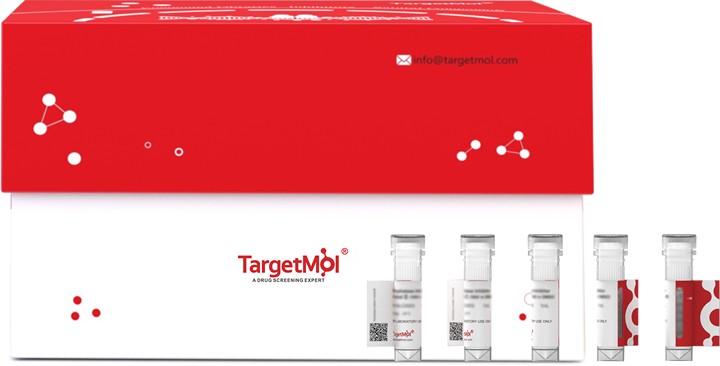- Remove All
 Your shopping cart is currently empty
Your shopping cart is currently empty
CAMKI gamma/CAMK1G Protein, Human, Recombinant (His & GST)
Calmodulin-Dependent Protein Kinase (CaM Kinase) is a kind of protein phosphorylate multiple downstream targets. Concentration of cytosolic calcium functions as a second messenger that mediates a wide range of cellular responses. Calcium binds to calcium binding proteins (calmodulin/CaM) and stimulates the activity of a variety of enzymes, including CaM kinases referred to as CaM-kinases (CaMKs), such as CaMKI, CaMKII, CaMKIV and CaMKK. Calmodulin-dependent protein kinase CL3/CaMKIγ is a memberane-anchored CaMK belonging to the CaM kinase family. Its C-terminal region is uniquely modified by two sequential lipidification steps: prenylation followed by a kinase-activity-regulated palmitoylation. These modifications are essential for CaMKIγ membrane anchoring and targeting into detergent-resistant lipid microdomains in the dendrites. It has been found that CaMKIγ critically contributed to BDNF-stimulated dendritic growth. Raft insertion of CaMKIγ specifically promoted dendritogenesis of cortical neurons by acting upstream of RacGEF STEF and Rac, both present in lipid rafts. Thus, CaMKIγ may represent a key element in the Ca2+-dependent and lipid-raft-delineated switch that turns on extrinsic activity-regulated dendrite formation in developing cortical neurons.

CAMKI gamma/CAMK1G Protein, Human, Recombinant (His & GST)
| Pack Size | Price | Availability | Quantity |
|---|---|---|---|
| 50 μg | $577 | 7-10 days |
Product Information
| Biological Activity | No Kinase Activity |
| Description | Calmodulin-Dependent Protein Kinase (CaM Kinase) is a kind of protein phosphorylate multiple downstream targets. Concentration of cytosolic calcium functions as a second messenger that mediates a wide range of cellular responses. Calcium binds to calcium binding proteins (calmodulin/CaM) and stimulates the activity of a variety of enzymes, including CaM kinases referred to as CaM-kinases (CaMKs), such as CaMKI, CaMKII, CaMKIV and CaMKK. Calmodulin-dependent protein kinase CL3/CaMKIγ is a memberane-anchored CaMK belonging to the CaM kinase family. Its C-terminal region is uniquely modified by two sequential lipidification steps: prenylation followed by a kinase-activity-regulated palmitoylation. These modifications are essential for CaMKIγ membrane anchoring and targeting into detergent-resistant lipid microdomains in the dendrites. It has been found that CaMKIγ critically contributed to BDNF-stimulated dendritic growth. Raft insertion of CaMKIγ specifically promoted dendritogenesis of cortical neurons by acting upstream of RacGEF STEF and Rac, both present in lipid rafts. Thus, CaMKIγ may represent a key element in the Ca2+-dependent and lipid-raft-delineated switch that turns on extrinsic activity-regulated dendrite formation in developing cortical neurons. |
| Species | Human |
| Expression System | Baculovirus Insect Cells |
| Tag | His, GST |
| Accession Number | Q96NX5-1 |
| Synonyms | VWS1,RP1-272L16.2,dJ272L16.1,CLICKIII,CLICK3,CaMKI γ/CAMK1G,calcium/calmodulin-dependent protein kinase IG |
| Construction | A DNA sequence encoding the human CAMK1G isoform 1 (Q96NX5-1) (Met 1-Met 476) was fused with the N-terminal polyhistidine-tagged GST tag at the N-terminus. Predicted N terminal: Met |
| Protein Purity | > 85 % as determined by SDS-PAGE |
| Molecular Weight | 81 kDa (predicted); 75 kDa (reducing conditions) |
| Endotoxin | < 1.0 EU/μg of the protein as determined by the LAL method. |
| Formulation | Lyophilized from a solution filtered through a 0.22 μm filter, containing 50 mM Tris, 100 mM NaCl, pH 8.0, 20% gly, 0.3 mM DTT. Typically, a mixture containing 5% to 8% trehalose, mannitol, and 0.01% Tween 80 is incorporated as a protective agent before lyophilization. |
| Reconstitution | A Certificate of Analysis (CoA) containing reconstitution instructions is included with the products. Please refer to the CoA for detailed information. |
| Stability & Storage | It is recommended to store recombinant proteins at -20°C to -80°C for future use. Lyophilized powders can be stably stored for over 12 months, while liquid products can be stored for 6-12 months at -80°C. For reconstituted protein solutions, the solution can be stored at -20°C to -80°C for at least 3 months. Please avoid multiple freeze-thaw cycles and store products in aliquots. |
| Shipping | In general, Lyophilized powders are shipping with blue ice. |
| Research Background | Calmodulin-Dependent Protein Kinase (CaM Kinase) is a kind of protein phosphorylate multiple downstream targets. Concentration of cytosolic calcium functions as a second messenger that mediates a wide range of cellular responses. Calcium binds to calcium binding proteins (calmodulin/CaM) and stimulates the activity of a variety of enzymes, including CaM kinases referred to as CaM-kinases (CaMKs), such as CaMKI, CaMKII, CaMKIV and CaMKK. Calmodulin-dependent protein kinase CL3/CaMKIγ is a memberane-anchored CaMK belonging to the CaM kinase family. Its C-terminal region is uniquely modified by two sequential lipidification steps: prenylation followed by a kinase-activity-regulated palmitoylation. These modifications are essential for CaMKIγ membrane anchoring and targeting into detergent-resistant lipid microdomains in the dendrites. It has been found that CaMKIγ critically contributed to BDNF-stimulated dendritic growth. Raft insertion of CaMKIγ specifically promoted dendritogenesis of cortical neurons by acting upstream of RacGEF STEF and Rac, both present in lipid rafts. Thus, CaMKIγ may represent a key element in the Ca2+-dependent and lipid-raft-delineated switch that turns on extrinsic activity-regulated dendrite formation in developing cortical neurons. |
Dose Conversion
Sci Citations
Calculator
Tech Support

Copyright © 2015-2025 TargetMol Chemicals Inc. All Rights Reserved.


